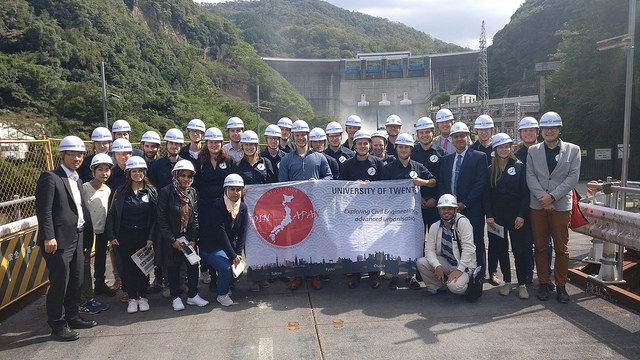Amagase dam

On October 12 the disaster prevention research institute of the Kyoto University took us to the Amagase dam. The Amagase dam is located on the south side of Kyoto and has only inflow from lake Biwa, which we already visited. Kyoto University chartered a bus to take us to the dam from the station where we met. After arriving the dam, we entered the main building next to the dam for an introduction of the dam and some information about the redevelopment that is currently taken place. Due to increased precipitation and an increased frequency of precipitation, the discharge of the dam has to be increased. They are doing this by adding a bypass with a capacity of 600m3/s which increases the current outlet capacity with 66%. The construction costs of this project are 95 billion yen and this is financed almost completely by the government. The construction is split into 3 pieces and for each piece another constructor is working on the bypass.
After the introduction of the projects, we went to the construction of the new inlet. The dam is mainly used for flood protection and therefor the dam cannot be emptied for the construction of the new bypass. A remote controlled excavator was developed for this project. This excavator can be used from ground level and has sensors to show what is happening at the bottom of the dam. There is no need for divers to check the state of the ground and therefor a lot of time is saved. The excavator will be used on other projects as well after finishing the Amagase dam.
Also the outlet of the new bypass was shown, which is 23m wide and 26m high. These dimensions are bigger compared to the tunnel before the gate shaft, which has a diameter of 10m. This is done to reduce the water speed and a smooth mixing with the water coming through the dam at other locations. The construction of the tunnel is very complicated, because it has to be drilled through the mountain. First a narrow drift is drilled, followed by strengthening the upper area. Then the drifts are widened to larger cross sections. This process is repeated several times.
The new bypass is only created for better flood control and no energy is generated. The bypass can also not be used for sediment transport, which means that the dam still needs to be excavated over time. There are ideas for sediment transportation through the dam, but these are not yet worked out into a plan. Sediment transportation through the dam is cheaper and does not influence nature.
